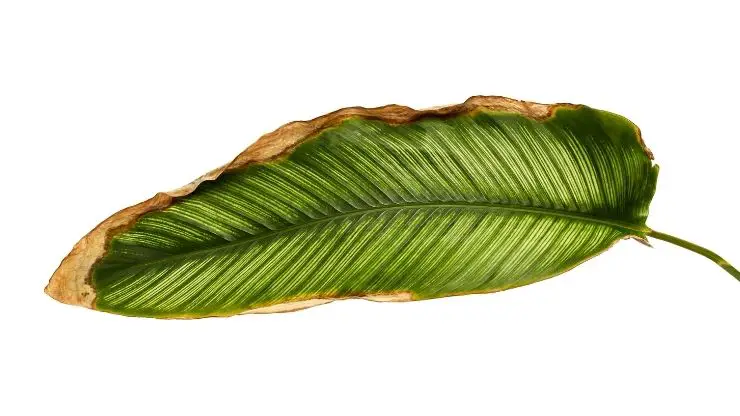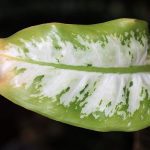
Calathea leaves curling is a sign that the air is too dry. All varieties of calathea require high humidity to thrive. When humidity is too low (i.e. the air is too dry), leaves can curl up and the edges may turn brown.
How to Fix Calathea Leaves Curling
To fix the curling leaves, you must increase humidity around the plant. Here are several ways you can do that:
- Mist the plant regularly. Fill a spray bottle with lukewarm water, set it to the “mist” setting, and spray the air around the plant’s leaves several times per day.
- Use a pebble tray. Fill a shallow tray with pebbles, and then fill about halfway up the pebbles with water. Place the plant onto the pebbles, making sure the bottom of the pot does not actually touch water. This is known as a humidity tray. (See my post on how to make a humidity tray for more information.)
- Place near a humidifier. If you live in a particularly dry place, or if air becomes very dry in the winter, it’s beneficial to place your plant in the same room as a high-quality houseplant humidifier. If you’re unsure about humidifiers, read my review of my favorite houseplant humidifier (the one I’m using right now) or click here to view it directly on Amazon.
Those are the best ways to increase humidity near your Calathea, which is the reason the leaves are curling in the first place. Also, make sure you place the plant somewhere that does not get blasted by warm air from wood stoves or heating vents.

Preventing Curling Leaves
Here are some other ways you can prevent your calathea leaves from curling in the future. Focus on increasing humidity first, then follow these care guidelines to keep the plant healthy and happy.
- Give your plant a shower. It may sound strange, but calathea benefits from a gentle shower from time to time. This cleans the leaves and increases humidity. I put my calathea into the bathtub, and then use the sprayer nozzle to gently spray the leaves with lukewarm water. Allow it to drain for an hour or two before moving back to its normal spot.
- Clean the leaves. This is something that many indoor gardeners – especially newbies – often neglect. To keep leaves healthy, wipe them down with a soft, damp cloth occasionally to remove dust, hair, and other debris. (See my post on how to clean your houseplant’s leaves for more information.)
- Water regularly. Calathea loves moist soil – not wet, but definitely never allow it to dry out. If you touch the top of the soil and it feels dry, water your plant immediately. Calathea is a tropical plant that needs high moisture and humidity at all times. It will likely need watering several times per week in an average home.
- Maintain the correct temperature. Maintain a temperature of 65 – 75 degrees F (18 – 24 degrees C). All varieties of calathea will thrive under these conditions, although some may tolerate slightly higher or slightly lower temperatures. Never allow the temperature to drop below 60 degrees F (15 degrees C).
If you follow these guidelines, you’ll have a healthy calathea plant and curling leaves won’t trouble you.

Other Tips to Keep Calathea Healthy
Light can also be an issue. Make sure you never place calathea in direct sunlight. This can dry out the leaves as well – and may even cause them to curl up or turn brown.
Bright, indirect sunlight is best for this plant, which originates on the jungle floor where it’s damp, moist, and shady. A north- or east-facing window is best. You can also place the plant 3 – 5 feet back from a bright window, or filter light with gauzy curtains.
And finally, make sure to check the care requirements for your specific variety of calathea to see if it needs any special care. Check out our guides on how to care for calathea ornata or calathea orbifolia if you own these plants.




